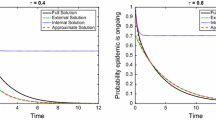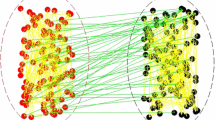Abstract
To investigate the impacts of demographics on the spread of infectious diseases, a susceptible-infectious-recovered (SIR) pairwise model on heterogeneous networks is established. This model is reduced by using the probability generating function and moment closure approximations. The basic reproduction number of the low-dimensional model is derived to rely on the recruitment and death rate, the first and second moments of newcomers’ degree distribution. Sensitivity analysis for the basic reproduction number is performed, which indicates that a larger variance of newcomers’ degrees can lead to an epidemic outbreak with a smaller transmission rate, and contribute to a slight decrease of the final density of infectious nodes with a larger transmission rate. Besides, stochastic simulations indicate that the low-dimensional model based on the log-normal moment closure assumption can well capture important properties of an epidemic. And the authors discover that a larger recruitment rate can inhibit the spread of disease.
Similar content being viewed by others
Explore related subjects
Discover the latest articles and news from researchers in related subjects, suggested using machine learning.References
Anderson R M, Jackson H C, May R M, et al., Population dynamics of fox rabies in Europe, Nature, 1981, 289(5800): 765–771.
Zhang J, Jin Z, Sun G, et al., Analysis of rabies in China: Transmission dynamics and control, PLoS One, 2011, 6(7): e20891.
Zhang J, Jin Z, Sun G, et al., Determination of original infection source of H7N9 avian influenza by dynamical model, Scientific Reports, 2014, 4(6183): 4846.
Ling M, Sun G, Wu Y, et al., Transmission dynamics of a multi-group brucellosis model with mixed cross infection in public farm, Applied Mathematics and Computation, 2014, 237(5): 582–594.
Ling M, Jin Z, Sun G, et al., Modeling direct and indirect disease transmission using multi-group model, Journal of Mathematical Analysis and Applications, 2017, 446(2): 1292–1309.
Pastor-Satorras R and Vespignani A, Epidemic spreading in scale-free networks, Physical Review Letters, 2001, 86(14): 3200–3203.
Newman M E J, Strogatz S H, and Watts D J, Random graphs with arbitrary degree distributions and their applications, Physical Review E, 2001, 64(2): 026118.
Pastor-Satorras R and Vespignani A, Epidemic dynamics and endemic states in complex networks, Physical Review E, 2001, 63(6): 066117.
May R M and Lloyd A L, Infection dynamics on scale-free networks, Physical Review E, 2001, 64(6): 066112.
House T and Keeling M J, Insights from unifying modern approximations to infections on networks, Journal of the Royal Society Interface, 2011, 8(54): 67–73.
Miller J C, Spread of infectious disease through clustered populations, Journal of the Royal Society Interface, 2009, 6(41): 1121–1134.
Molina C and Stone L, Modelling the spread of diseases in clustered networks, Journal of Theoretical Biology, 2012, 315: 110–118.
Volz E M, Dynamics of infectious disease in clustered networks with arbitrary degree distributions, Eprint Arxiv, 2010.
Miller J C, Percolation and epidemics in random clustered networks, Physical Review E, 2009, 80(2): 020901.
Lindquist J, Ma J, van den Driessche P, et al., Effective degree network disease models, Journal of Mathematical Biology, 2011, 62(2): 143–164.
Volz E M, SIR dynamics in random networks with heterogeneous connectivity, Journal of Mathematical Biology, 2008, 56(3): 293–310.
Volz E M and Meyers L A, Susceptible-infected-recovered epidemics in dynamic contact networks, Proceedings of the Royal Society, 2007, 274(1628): 2925–2933.
Miller J C, A note on a paper by Erik Volz: SIR dynamics in random networks, Journal of Mathematical Biology, 2011, 62(3): 349–358.
Kamp C, Untangling the interplay between epidemic spread and transmission network dynamics, PLoS Computational Biology, 2010, 6(11): e1000984.
Kamp C, Demographic and behavioural change during epidemics, Procedia Computer Science, 2010, 1(1): 2253–2259.
Jin Z, Sun G, and Zhu H, Epidemic models for complex networks with demographics, Mathematical Biosciences and Engineering, 2014, 11(6): 1295–1317.
Piccardi C, Colombo A, and Casagrandi R, Connectivity interplays with age in shaping contagion over networks with vital dynamics, Physical Review E, 2015, 91(2): 022809.
Erdös P and Rényi A, On random graphs I, Publicationes Mathematicae, 1959, 6: 290–297.
Eames K T D and Keeling M J, Modeling dynamic and network heterogeneities in the spread of sexually transmitted diseases, Proceedings of the National Academy of Sciences of the United States of America, 2002, 99(20): 13330–13335.
Simon P L and Kiss I Z, Super compact pairwise model for SIS epidemic on heterogeneous networks, Journal of Complex Networks, 2016, 4(2): 187–200.
Bauch C T, The spread of infectious diseases in spatially structured populations: An invasory pair approximation, Mathematical Biosciences, 2005, 198(2): 217–237.
Trapman P, Reproduction numbers for epidemics on networks using pair approximation, Mathematical Biosciences, 2007, 210(2): 464–489.
Keeling M J, Multiplicative moments and measures of persistence in ecology, Journal of Theoretical Biology, 2000, 205(2): 269–281.
Ekanayake A J and Allen L J S, Comparison of markov chain and stochastic differential equation population models under higher-order moment closure approximations, Stochastic Analysis and Applications, 2010, 28(6): 907–927.
Miller J C and Kiss I Z, Epidemic spread in networks: Existing methods and current challenges, Mathematical Modelling of Natural Phenomena, 2014, 9(2): 4–42.
N˚asell I, An extension of the moment closure method, Theoretical Population Biology, 2003, 64(2): 233–239.
Whittle P, On the use of the normal approximation in the treatment of stochastic processes, Journal of the Royal Statistical Society, 1957, 19(2): 268–281.
Goutsias J and Jenkinson G, Markovian dynamics on complex reaction networks, Physics Reports, 2013, 529(2): 199–264.
Hiebeler D, Moment equations and dynamics of a household SIS epidemiological model, Bulletin of Mathematical Biology, 2006, 68(6): 1315–1333.
Krishnarajah I, Cook A, Marion G, et al., Novel moment closure approximations in stochastic epidemics, Bulletin of Mathematical Biology, 2005, 67(4): 855–873.
Anderson R M and May R M, Infectious Diseases of Humans, Oxford Science, Oxford, 1991.
Author information
Authors and Affiliations
Corresponding author
Additional information
This research was supported by the National Natural Science Foundation of China under Grant Nos. 11331009, 11471197, 11501340, and 11601294, as well as the Youth Science Fund of Shanxi Province under Grant No. 2015021020.
This paper was recommended for publication by Editor DI Zengru.
Rights and permissions
About this article
Cite this article
Jing, W., Jin, Z. & Zhang, J. Low-Dimensional SIR Epidemic Models with Demographics on Heterogeneous Networks. J Syst Sci Complex 31, 1103–1127 (2018). https://doi.org/10.1007/s11424-018-7029-8
Received:
Revised:
Published:
Issue Date:
DOI: https://doi.org/10.1007/s11424-018-7029-8




